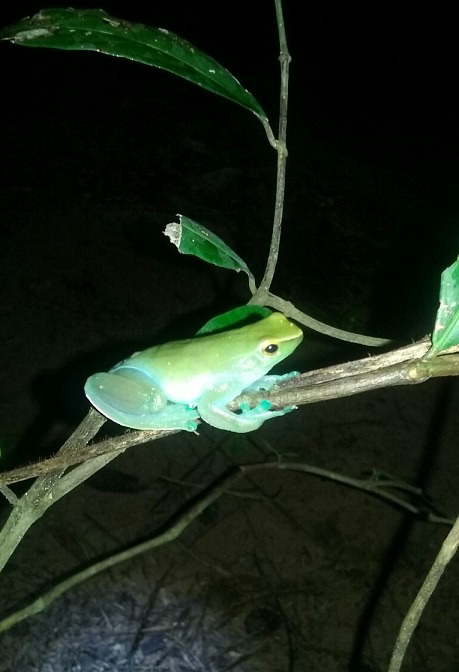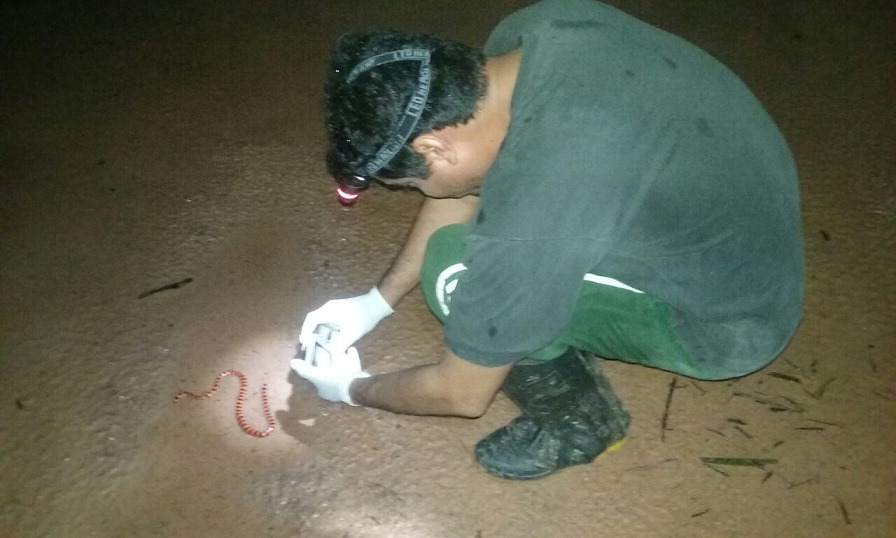Cycle 3 (2014 Deadline) Biodiversity and socio-economic impacts of palm oil bioenergy development in the Brazilian Amazon PI: Rodrigo Medeiros ( rmedeiros@conservation.org), Conservation International do Brasil, with co-PI Luciano Montag, Universidade Federal do Pará U.S. Partner: Kathleen E. Halvorsen, Michigan Technological University
Project Dates: October 2014 to June 2019
This research project focuses on biofuel development that impacts forested systems, one of the most controversial types of energy development today (NRC-NAS 2011). The research is expected to advance science sustainability and further the understanding of impacts of palm oil biofuel development on socioecological systems in Brazil. Clean renewable energy policies, biodiversity conservation, and economic development are often studied, but generally in isolation. Using an in-depth case study approach, this project will fully integrate social and ecological scientific methods. The main benefits of this research will be: (1) understanding rural community level socioecological impacts of palm oil expansion; (2) designing policy measures that promote continuous social inclusion and biodiversity-friendly palm oil production; (3) developing new sustainability science indicators and metrics using results from the socioeconomic and biodiversity studies; and (4) increasing the research capacity of the Pan American partner institutions for graduate and postgraduate student education specializing in sustainability issues.
The results of this research project will have important consequences for the long-term sustainability of biofuel feedstock, human communities, and biodiversity conservation. The project’s final results will be shared at relevant national and international conferences and also with key regional and local stakeholders in efforts to improve small landholders’ economic benefits from palm oil and facilitate inclusion of marginalized groups in the palm oil sector. Policy recommendations from this research will assist Brazilian government institutions in policy development to increase local and national socioeconomic benefits, promoting energy independence and small landholder’s inclusion, while minimizing impacts on existing biodiversity, hence achieving sustainability. The expected project impacts are closely aligned with USAID’s interests, especially in the biodiversity, environment, and agriculture categories, since the project’s final goal is to suggest a sustainable and economically viable palm oil agriculture model in Brazil that can be a model for other developing countries in the region. Consistent with USAID’s approach, this project is taking a cross-sector approach addressing a major threat to biodiversity conservation, economic growth, and, to a lesser extent, human health and global climate change.
Final Summary of Project Activities
 |
Following is the final project summary as provided by Conservation International:
“We closed a five-year cycle of biodiversity monitoring in which researchers registered 270 species of birds, 74 species of fishes, 33 species of amphibians and reptiles, 32 species of spiders, 36 species of bees, 119 species of ants, 25 species of flies, and 78 different genera of aquatic insects. Within this biodiversity at least 22 species are endemic, rare, or new, highlighting the importance of biodiversity monitoring in that region. The results for fauna diversity and abundance show differences between legal reserve forests and palm oil plantations, with unique species occurring in both environments. At the same time, the data analysis showed that a conserved riparian forest around water streams maintains a higher environmental quality. For species with wide home range, sustainable palm oil plantation seems to be a good option for ecological corridors, mainly when compared to other commodities chains as soy, corn, and cattle.
“For socioeconomic analysis, the territorial cutting used was Tomé-Açú microregion, which comprises five municipalities: Tomé-Açu, Mojú, Tailândia, Acará. and Concórdia. This region was chosen because it produces almost 90% of the Brazilian palm oil. The region is also a large-scale producer of soybean, coconut, orange, cocoa, corn, and cattle, among other commodities. The total GDP of the municipalities is high due to the productivity of these commodities in the region, reaching US $266,000; however, when the analysis is made considering the monthly per capita income average, the values fluctuate between US $40 to US$135, below the Brazilian minimum wage. The education level in the region is low, with an almost 30% illiteracy rate in the five municipalities and only 4% of workers attaining higher education. The region has a high unemployment rate, averaging around 10%, and about 50% of employed people work in agriculture activities. The Human Development Index is low according to UNDP, with values under 0.599 and, according to the FIRJAN (a Brazilian organization that develops and coordinates studies, research and projects to guide industrial promotion actions and new investments) Municipal Development Index, the municipalities of the region are classified between regular and moderate development: 0.502 to 0.697. When we analyze the results of the GINI coefficient of CEB municipalities—between 0.5001 and 0.6500—we can conclude that despite the region's high total GDP, the income distribution is deficient and the region is highly vulnerable to poverty, between 60 and 80%, according to UNDP.
“Hoping to better understand community perception about the region’s socioeconomics, especially related to palm oil production for biofuel development, a randomized survey was applied in 21 communities near established palm oil plantations. The interviews were done in 295 households to assess participants’ perceptions on potential impacts of the expansion of palm oil plantations, on both environmental and socioeconomic features, as well as participants’ support of palm oil production expansion. These interviews also assessed respondents’ environmental values, registering their opinion on the importance of certain natural attributes, the capacity of agriculture to provide these attributes, and the relevance of nature compared to economic growth and traditional ways of life. Furthermore, the interviews registered participants’ attitudes toward climate change, energy production, and palm oil public policies. Additionally, characterizing the respondents’ profiles enabled the analysis of different influences on their perceptions. Most participants considered natural attributes listed to be important and also considered that palm oil crops do not provide these attributes and that other food crops do. For palm oil expansion, most of participants foresaw negative impacts on environmental features. On the other hand, respondents considered this expansion to deliver positive impacts to socioeconomic features of the region. Considering these potential impacts, most respondents affirmed they would support palm oil crop expansion.
“The main variable that significantly influenced perceptions was the relation of the participants with palm oil plantations—i.e., if the respondent was a palm oil farmer (landowner), a palm oil company worker (not a landowner), or had no relation with palm oil production. The palm oil farmers had less environmental values when compared to participants who are palm oil company workers or who do not have any relationship with palm oil. People with no relation with palm oil showed more negative perceptions about the environmental impacts of palm oil expansion than the palm oil farmers or workers. Despite a few positive perceptions, the negative socioeconomic and environmental impacts perceived by people who do not directly depend on palm oil plantations need to be considered to improve palm oil policies in the Eastern Brazilian Amazon. Our research shows the need to fully address local communities’ concerns, providing regular assessment of socioeconomic and environmental impacts, as well as information sharing with local stakeholders.
“Concerning geodatabase analysis, the results showed that CEB is one of the richest areas in the Amazon but also one of the most threatened, since around 70% of its territory is already degraded, and the pressure for native vegetation replacement for low productivity extensive crops and livestock is increasing. This context brings up the great challenge for the region’s development, which seeks to innovate with productive activities that generate jobs and income for the local population, without destroying valuable natural capital. In 2010, Palm Oil Agroecological Zoning (ZAE) was carried out to delineate the areas with suitable soil and climate for palm oil cultivation. The palm oil plantations in this region account for about 90% of Brazilian palm oil production. This environmental, social, and economic context, together with the development of partnerships with the productive sector, NGOs, universities and governments in projects that catalyze the sustainable development of the region, brings to the Tomé-Açu microregion an important opportunity for the planning and implementation of ecological corridors, which are the basis for promoting sustainable development in the region. From 1988 to 2017, the palm oil area in Brazil increased 155% (from 43.500 hectares to 111.400 hectares) and the productivity around 170% (from 5.57 ton/ha to 15 ton/ha). Brazil is now ranked 15th among the largest palm growers in the world. The relationship between deforestation and palm oil expansion is present in several countries in Asia, Africa, and South America, but for Brazil it is not a reality. The palm oil planted area is much lower than the annual forest loss, and current legislation prevents new areas of palm crops from being planted as a result of direct forest conversion. The increase in palm oil plantations in Brazil from 1990 to 2016 was around 4,000 hectares, and the deforestation for the same period around 2 million hectares. Thus, it’s highly improbable that palm oil expansion will be an important vector for deforestation in Brazil.
“This information confirms that palm oil cultivation in the microregion of Tomé Açú does not displace forests directly and may represent an opportunity for the occupation of degraded areas, associated with forest restoration in the landscape. In order to be in accordance with RSPO criteria the properties must comply with the Brazilian forest code. At the same time, it is possible to see the high economic importance of palm production activity for the microregion, especially in Concórdia do Pará and Tailândia, where the value of palm production reaches about 90% and 50%, respectively, of agroindustry GDP. The spatial data analysis confirms there is an opportunity for forest restoration in the microregion, due to the need to adapt rural properties to the Brazilian Forest Code and the high concentration of deforested areas in private properties in the region.
“If the full restoration of the degraded Legal Reserves is considered, approximately 280,000 hectares could be restored. If we consider only the 80% of Brazilian Forest Code, at least 100,000 hectares would need restoration (Acará – 18,000 hectares; Concórdia – 11,500 hectares; Mojú – 39,000 hectares; Tailândia 10,000 hectares; Tomé-Açú – 25,000 hectares). For permanent riverbank preservation areas there are about 65,000 additional hectares. The southwest, southeast, and midwest of the microregion contain the largest proportions of priority conservation areas, especially in the Moju and Tailândia municipalities. To the north there are important areas, mainly on the banks of the Acará and Moju rivers near the river’s mouth. Priority areas for restoration are clearly concentrated in the south-central microregion, mainly in Tailândia municipality with around 88 thousand hectares subject to restoration. The concentration of priority areas for the palm crops expansion are mainly in the north of the microregion, concentrated in the municipalities of Concórdia do Pará, Acará and Moju, especially in Acará which has about 80 thousand hectares with potential for expansion. Analysis of the three data layers together generates new information about sustainable development corridors in the region. For instance, there is high potential for forest conservation in the Tomé-Açú and Tailândia municipalities, and potential for palm oil expansion in the Acará and Concórdia municipalities. These results show the potential for development of palm oil production in the region of Tomé Açú microregion without deforestation and with opportunities for forest restoration in the landscape. They also highlight the need for further analysis by means of geoinformation layers that can promote a better understanding of spatial patterns of territorial dynamics in the region.”
Although the PEER project has now ended, the team at Conservation International is continuing related work thanks to support from Agropalma, and this partnership has a good chance of continuing in 2020 and beyond. They are also exploring other avenues of support for a proposed project on landscape restoration in the Belém Endemism Center.
Back to PEER Science Cycle 3 Grants
|





